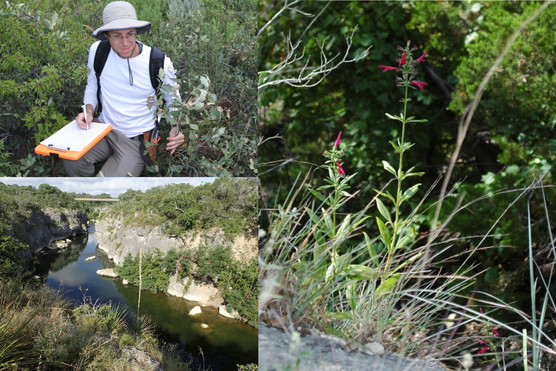Conserving genetic diversity of the endangered Texas endemic, big red sage, Salvia pentstemonoides
Wednesday, July 15, 2020
12:00 p.m. - 1:00 p.m. CST
Dr. Sean Hoban
Tree Conservation Biologist
The Morton Arboretum
 Sean Hoban sampling plant diversity (in this case shinnery oak) in Texas in 2016. Big red sage and big red sage habitat.
Genetic diversity analysis can help inform how to conserve endangered plants. In this talk, Sean will describe how to develop a conservation genetic project, some common obstacles, and how to interpret results using a recent study. Salvia pentstemonoides (big red sage) is a highly threatened (NatureServe G1- the most critical level) plant native to Texas. There are less than 10 populations, perhaps only 5, in existence. Only two of these populations exceed 100 plants; the remaining populations are all less than 50 plants. The plant is highly charismatic, and can be ordered through some specialty nurseries. It is also beautiful and interesting, and is found in botanic gardens. We performed two research efforts to inform conserving the species: (1) Determine whether small populations have lower genetic diversity and/or higher inbreeding than the larger populations. (2) Compare the genetic diversity in wild populations to those in nurseries and botanic gardens.
As Tree Conservation Biologist at The Morton Arboretum, Dr. Sean Hoban works to understand, document, and conserve plant species, both rare and common. Dr. Hoban has published 49 peer-reviewed scientific articles and presented his work at dozens of regional, national, and international conferences. He is also an Editor for the journal Conservation Genetics. He has contributed technical expertise to several government agencies, including helping develop a new management policy in South Africa. Before coming to the Arboretum, Dr. Hoban received a PhD from The University of Notre Dame, under Dr. Jeanne Romero-Severson. He then worked as a postdoctoral researcher in France and Italy, and as a fellow at the National Institute for Mathematical and Biological Synthesis in Knoxville, Tennessee.
Note: Registration via mobile devices is not supported. You must register using a computer.
To view upcoming or archived Wildlife Diversity Webinar topics, visit the TPWD Wildlife Diversity Program page.
Sign up to receive future Wildlife Diversity Webinar Announcements
|